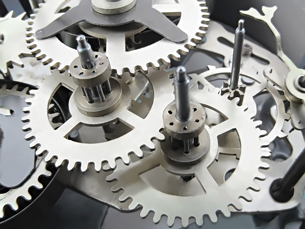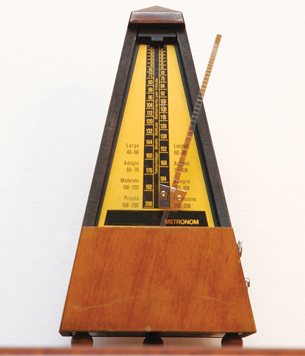Module 7—Oscillatory Motion
 Reflect and Connect
Reflect and Connect

© Samsonov Juri/shutterstock
For a clock to be useful, it has to keep the same time as every other clock in the world.
If it runs too fast or too slow, it won’t keep good time. The second hand must rotate once every 60 seconds, and the minute hand must complete one rotation in 60 minutes. The hour hand rotates once every 12 hours. How can a single pendulum, such as that seen in a grandfather clock, coordinate all of these hands moving at different rates? The simple harmonic motion of the pendulum is used to control a series of gears. The speed of each hand is controlled by the ratio of the gears. As long as the length of the pendulum and the acceleration due to gravity are constant, the pendulum will oscillate with a regular period.
This keeps the gears rotating at a regular speed and the hands of the clock moving just as you would want. Your clock gives you the regular motion needed by a timepiece.
At the bottom of the pendulum is a small adjustable weight. Moving this weight will change the period of the pendulum a small amount. If the clock is running fast, the adjustable weight is moved down on the pendulum. If the clock is running slow, the adjustable weight is moved up on the pendulum. (It’s a quick way to change the pendulum’s length.)
 Discuss
Discuss

© Goncalo Veloso de Figueiredo/shutterstock
A metronome is a timing device used to produce a periodic, audible tone or beat for establishing tempo in a musical performance. (Usually, a metronome is used when practising and not when performing.) The metronome to the right consists of a thin vertical bar that a small weight slides along (shown in the photograph near the bottom of the thin bar). Like the pendulum clock, if you move the weight closer to the end or the top of the pendulum, the pendulum will slow down. If you move the weight farther from the end of the pendulum by sliding the weight down to the bottom, the pendulum speeds up. You may think of this as an inverted pendulum, with a period that is much more easily adjustable than the pendulum clock. In the discussion forum, explain how moving the weight along the vertical bar causes the period to change. What variable in the equation for the period of a pendulum is being adjusted? How is the variable adjusted?
 Reflect on the Big Picture
Reflect on the Big Picture
Each of the Reflect on the Big Picture sections in this module will help you reinforce your learning about oscillation. Complete at least one of these reflection activities:
- Some early timekeeping devices are still used today. Others have been mostly forgotten. Use the Internet to research early timekeeping devices. Prepare an audio or video presentation about the devices you found that use regular, evenly spaced events.
- Create a short speech (1 to 2 minutes) about how music and timekeeping are related. Share it in the discussion area.
Store your completed reflection in your Physics 20 course folder.
 Module 7: Lesson 2 Assignment
Module 7: Lesson 2 Assignment
Submit the Module 7: Lesson 2 Assignment to your teacher.